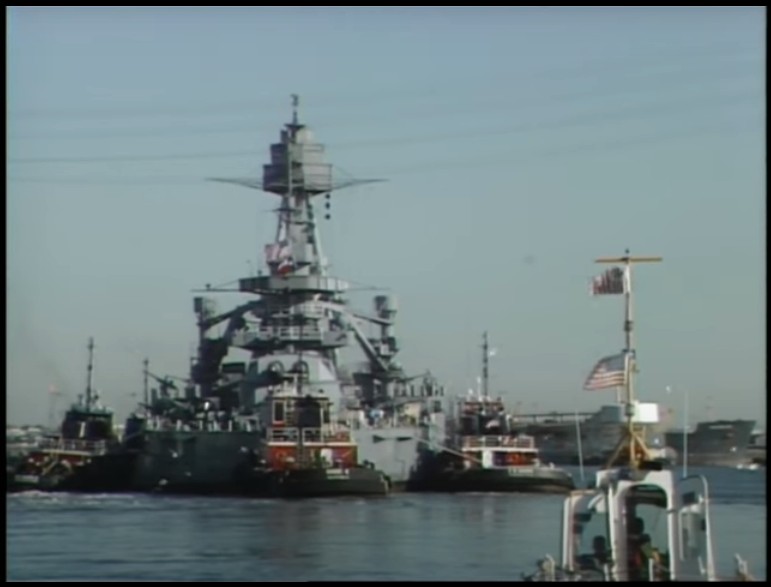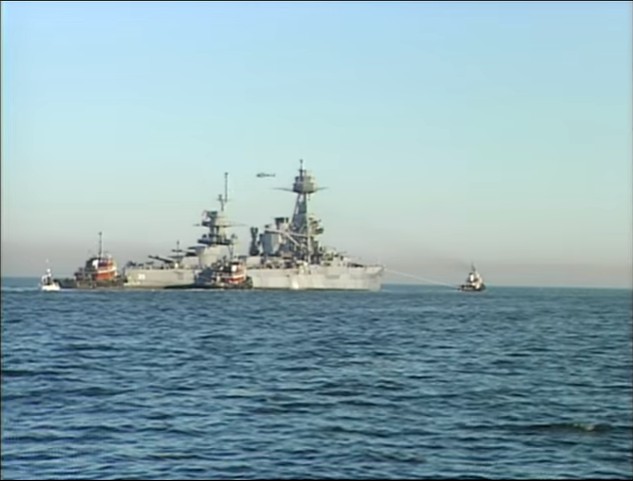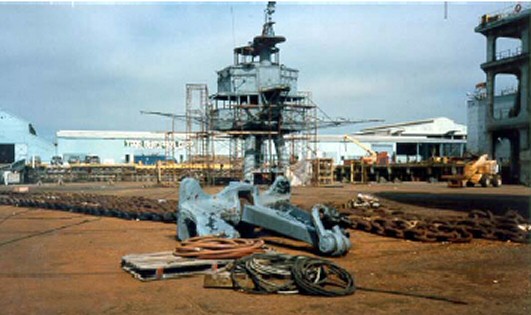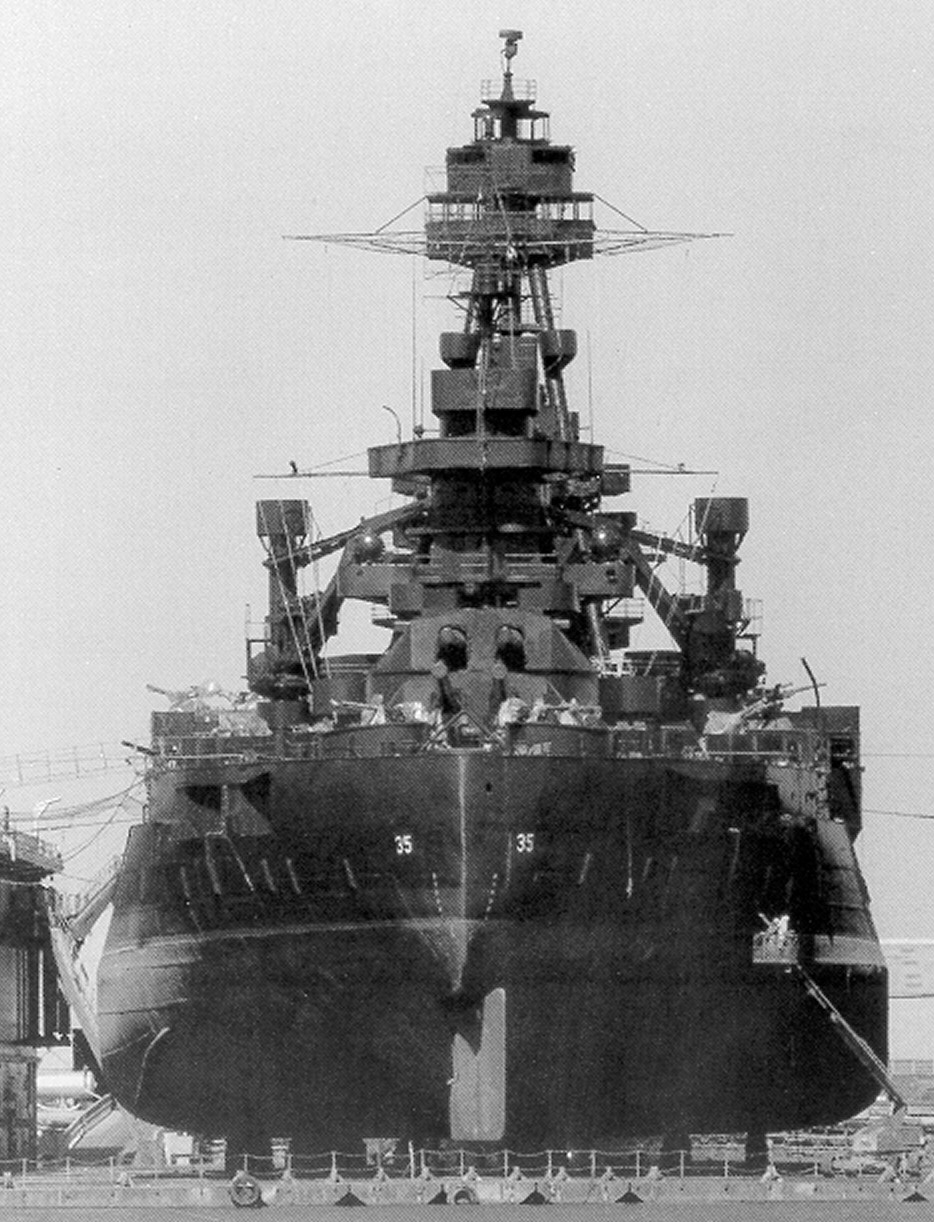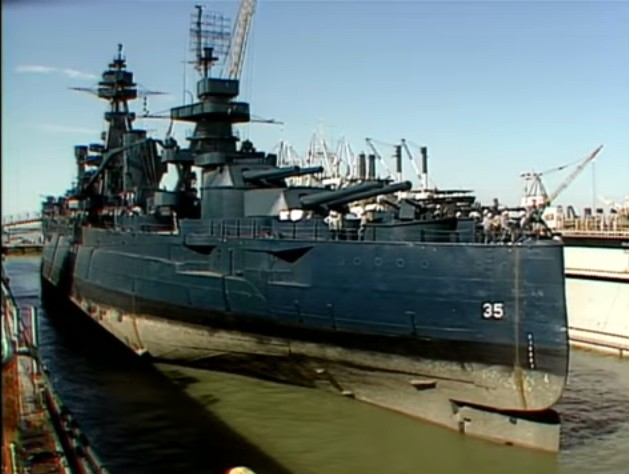.
.
By 1983, TEXAS had deteriorated badly over the 35 years since being brought
to San Jacinto on 19 April 1948. The public area condition that visitors could
see was run down but it was the below-the-water-line deterioration that raised
alarm about the ship's survivability. Lower interior areas were full of water
and structural support in some areas had failed. The ship's administrators, The
Battleship TEXAS Commission, lacked the finances to maintain the ship. So it was
on 1 September 1983 that responsibility for BB35 was transferred to Texas Parks
and Wildlife Department. In 1985, Naval architect Ed Phillips said
20% of the double bottom was exposed to water
Historical Comparison: 1988-1990 dry dock to the upcoming 2021 dry
dock: The hull as of 2021, after the prep work is in better shape
then in December 1988
|
|
1985 - Flooded : Aft Steering |

i |
 |
|
|
1985 - Flooded : Aft Steering |
|

|
|
 |
|
| |
|
Given the condition of the hull, it was imperative that BB35 be removed from the
water to repair the damage. The method chosen was to move the ship to a dry
dock. The bidding process included a submission from Tampico, Mexico.
The financial aspect of the needed hull-exterior work and berth improvements was
enormous. Many groups were involved to come up with the money, which eventually
totaled $14,000,000. Donated services saved hundreds of thousands of dollars.
Before TEXAS could be moved, structural work was needed.
The biggest task was pumping out 1.5 million gallons of fuel oil and water.
The after trim tank, which is below the Steering Room and Steering Gear Room had
lost structural integrity and had to be reframed.
Welding in the Engine Room was done to restore water tight integrity between the
two engine rooms.
Replacing gaskets on water-tight doors
Pumps were installed throughout to handing flooding during the tow to Todd’s.
In addition to the structural work, thousands of artifacts were inventoried and
removed. |
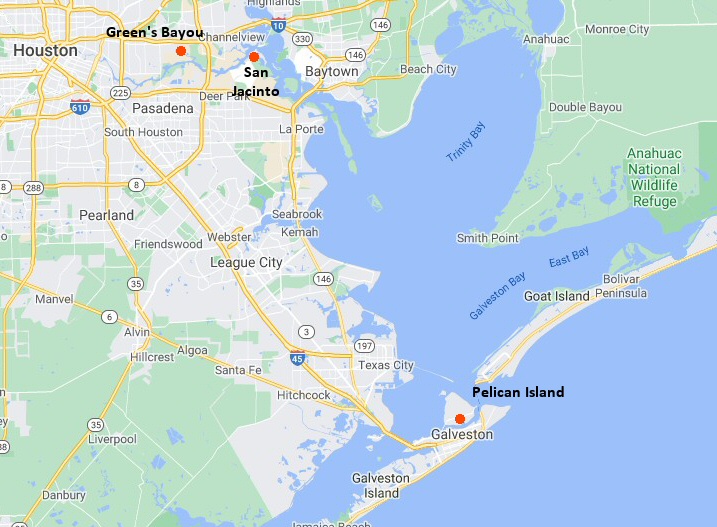 |
On 13 December (a cold morning), at 6am, tugboats began tying up to the stern and
pulled, but the ship did not budge. TEXAS was being held in her berth by 40
years of silt that had washed into the berth and pilled up around the hull.
Additional tugboats were brought in, till there were six tugs with 25,000hp
pulling on the lines and their propeller wash blowing away the silt from the
hull. During the pulling, one tug blew an engine and one tow line broke with the
sound a high powered hunting rifle firing. (I was there and saw-heard the line
break). By 1:13pm, the horse power pulling on the tow lines and propeller wash
finally pulled TEXAS from her berth and into the ship channel.
|
| |
First Texas Volunteers
(L-R) Bernard Olive (red jacket), Eddie Bor...(can't spell it), John Jeter
TPWD allowed three volunteers. The group met and selected these three |

Eddie Again at the Bow |
 |
.By the time TEXAS was turned in the ship channel for the tow south, flooding
alarms, had already gone off. Because the rudder was frozen 14.5 degrees to
starboard, one extra tugboat was need on the port side at the stern to
counteract the rudder.
|
 |
 |
| The 40 mile tow to Todd’s was to take 10 to 12 hours, at a maximum speed of 4
miles per hour. The tow speed though was increased and TEXAS arrived at Todd’s
at 9:05pm. By the time TEXAS was being pushed into the Todd’s dry-dock (on
Pelican Island) the
clearance between the keel and the dry-dock blocks was 6 inches. |
| |
|
Hull Repairs |
| |
| More fluid removal |
| Before hull metal replacement could begin, 13,000 barrels (460,000 gallons)
of additional oil and oily water had to be removed to purge flammable gasses.
1,500,000 gallons had been removed prior to the tow to Todd's |
|
10,000 ultrasonic sound tests |
|
for hull metal thickness |
|
235,000 pounds of outer Hull plate replaced |
| where the metal
was less than 3/8-inch thick. 10,000 ultrasonic soundings were taken to
determine hull thickness. |
|
Wash With Acid and Abrasive Blast |
| Before the hull was painted, a bath of phosphoric acid was applied to
neutralize the 40 years of San Jacinto Ship Channel chlorides. The acid bath was
followed by an abrasive blasting. |
| |
|
The Bow |
White spots
some of the 10,000 ultrasonic
testing locations for hull thickness |
| |
| Below - scan of TPWD photo |
 |
| |
| The Stern |
| Concrete on main deck removed |
The concrete poured in late 1968 - early 1969 on the main deck and the
superstructure was removed. Naval architect Ed Phillips said this could have
only been done in a drydock. The work needed was extensive. The metal deck below the concrete had rusted through
in many areas and was replaced. Notice the backhole close to the stern.
|
 |
Note the original navy gun foundations and
splinter shield locations surrounding the foundations
Pair in the foreground - 20mm. Aft-outboard - 40mm mount |
 |
| |
|
Missing splinter shields fabricated and installed |
| at the
94 anti-aircraft gun locations, except two 40mm gun mounts, on the
superstructure.aft |
|
SK radar antenna |
: Fabricated by volunteer father and son and installed on the mainmast.
The WWII antenna was destroyed during the 1961 Hurricane Carla
|
| |
| When the work at Todd's was finished BB35 was move to Green's Bayou while
the berth improvements at San Jacinto were being completed. Green's Bayou is
about 8 miles west of the San Jacinto Battleground. |
| |
| Tow to
Green's Bayou - 23 February |
 |
| FTV welder Kirby Taylor (right) - hourly
inspection of tanks for leaks |
 |
| Passing San Jacinto Monument |
| |
 |
 |
 |
 |
| |
| At
Green's Bayou |
| |
| Wood Deck Installed |
26,660 square feet of 4inch x 4inchx 16foot yellow pine was used for the main
deck and superstructure. The wooden deck cost $1,750,000.
A LOT of angles had to be cut |
 |
| Threaded studs attached to the deck to secure the wood |
 |
 |
| |
Attachment for Monopile Mooring
|
 |
To attach the below structures to the hull, holes
were made through the hull
The penetration brought out bits of the hull wood which was still good wood.
That is correct....wood. |
 |
| Installed Most to 40mm mounts |
| Most of the 10 mounts of 40mm anti-aircraft machine cannons were brought aboard.
While not the TEXAS mounts of World War Two, they are the correct types. The
rest were installed when BB35 returned to San Jacinto |
| Installed most of the Mark 51
Gun Directors |
| Most of the 10 Mark 51 Gun Directors were brought aboard. The director was by
which one sailor or marine could train, elevate and fire one 40mm gun mount. In
1945, even though 10 40mm mounts were aboard; there were 12 Mark 51 gun
directors. |
| First Interior Space Restored |
| The Sick Bay being was as a
donation by the wood deck contractor. |
 |
| Going under the Beltway 8 Bridge |
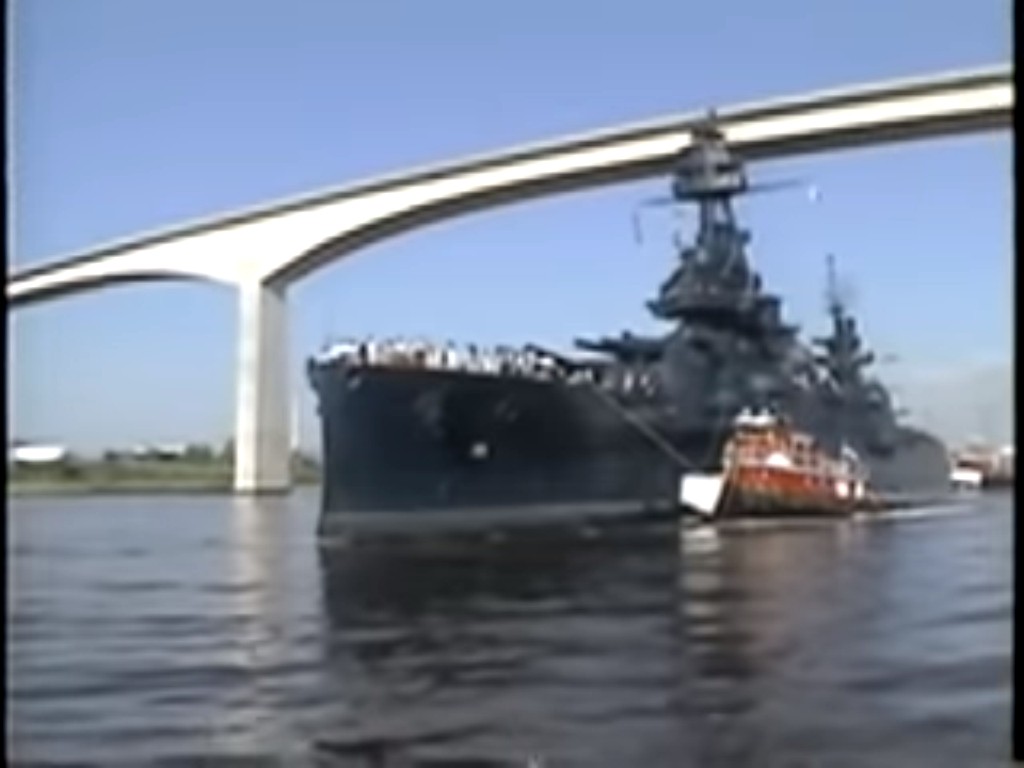 |
Band
Above the Crew's Galley, starboard (camera point aft) |
 |
| BB35 Veterans at the Bow |
 |
| BB35 Veteran Russell Pendellbury being
photographed |
 |
| |
| Arriving at San Jacinto |
 |
 |
 |
| |
| 28 July 1990 the ship returned to San Jacinto to an improved berth that was
widened and deepened. Mooring system of 4 monopiles on the starboard side that
were driven 70 feet into the bed of the the berth. |
The final work was completed, which included bringing aboard and securing the
remaining 40mm gun mounts. Gun mount 8, port of the Crew's Galley had been on
the MISSOURI. I was part of the gun crew that fastened down the mount. On the
back side are two horizontal cylinders with a screw cap. When one of the caps was removed,
US Navy papers were found documenting that the gun had been removed from
MISSOURI.
Restoration of the interior spaces continued. |
.









